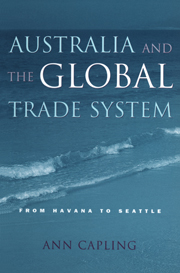Book contents
- Frontmatter
- Contents
- List of Tables and Figures
- Acknowledgments
- List of Abbreviations
- Introduction
- 1 ‘The Enfant Terrible’: Australia and the Reconstruction of the Multilateral Trade System
- 2 Coming to Terms with Multilateralism
- 3 Damage Control, Policy Stasis and Diplomatic Paralysis
- 4 Policy Innovation, Diplomatic Departures and the Uruguay Round
- 5 The Cairns Group
- 6 Aggressive Multilateralism: Negotiating Services
- 7 The American Way? Aggressive Bilateralism in Australian Trade Policy
- 8 The WTO System in Crisis
- Conclusion
- Appendix 1 Departments and Ministers responsible for GATT/WTO Negotiations
- Appendix 2 GATT Trade Runds
- Notes
- Index
3 - Damage Control, Policy Stasis and Diplomatic Paralysis
Published online by Cambridge University Press: 07 October 2011
- Frontmatter
- Contents
- List of Tables and Figures
- Acknowledgments
- List of Abbreviations
- Introduction
- 1 ‘The Enfant Terrible’: Australia and the Reconstruction of the Multilateral Trade System
- 2 Coming to Terms with Multilateralism
- 3 Damage Control, Policy Stasis and Diplomatic Paralysis
- 4 Policy Innovation, Diplomatic Departures and the Uruguay Round
- 5 The Cairns Group
- 6 Aggressive Multilateralism: Negotiating Services
- 7 The American Way? Aggressive Bilateralism in Australian Trade Policy
- 8 The WTO System in Crisis
- Conclusion
- Appendix 1 Departments and Ministers responsible for GATT/WTO Negotiations
- Appendix 2 GATT Trade Runds
- Notes
- Index
Summary
It is important not to lose sight of the fact that without genuine commitment to GATT reform by the major powers – United States and the European Community – the efforts of smaller countries like Australia could only ever meet with partial success. Nevertheless, Australia's record of GATT activism in the 1940s and 1950s had demonstrated that skilful diplomacy could produce tangible progress towards the achievement of these goals. Lacking either the political or economic clout to impose its preferences on the GATT, Australia resorted to other tactics that drew on the creative use of behavioural power. For instance, in 1947 Australia had exploited its status as a ‘key country’ with the power to veto the birth of the GATT in order to flex extra negotiating muscle in reaching a satisfactory bilateral agreement with the United States. With the subsequent growth of the GATT's membership and the declining symbolic and economic importance of the imperial preferential system, Australia lost its status as a ‘key country’ and thus its veto power. Although this narrowed the range of options, there were still other tactics available; during the 1950s Crawford's intelligent, patient and persistent diplomacy led to growing international awareness and understanding of some of the problems associated with agricultural protectionism. This was a necessary first step to any subsequent international action to tackle the problems associated with practices such as surplus disposals and export subsidies.
- Type
- Chapter
- Information
- Australia and the Global Trade SystemFrom Havana to Seattle, pp. 66 - 94Publisher: Cambridge University PressPrint publication year: 2001



